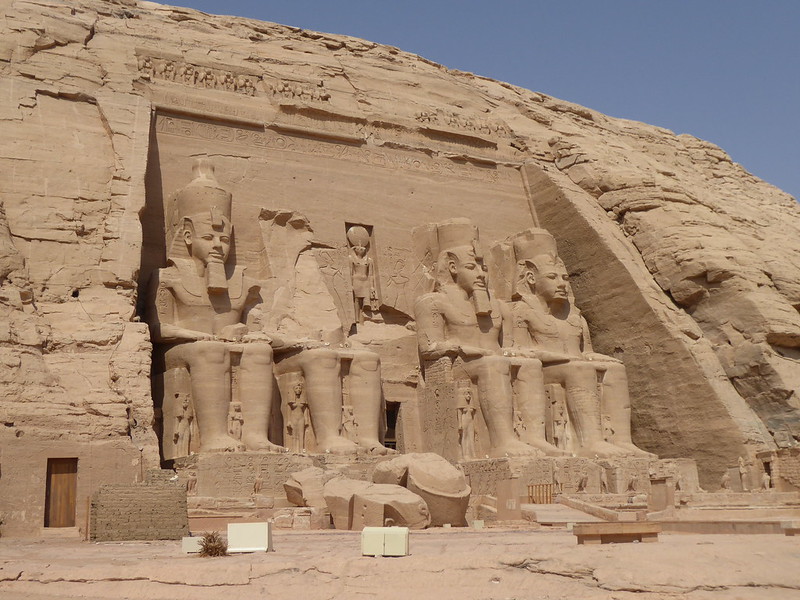Abu Simbel: A Majestic Wonder in Egyptian Sands

Deep within the sands of southern Egypt lies Abu Simbel, a testament to the power and grandeur of the Kings. Constructed by Pharaoh Ramses II during the 13th century BC, these colossal temples are truly remarkable, built directly into the cliffs and adorned with intricate sculptures and hieroglyphics. The temple complex consists of two main structures: a larger temple dedicated to Ramses II and a smaller one honoring his beloved queen, Nefertari.
The sheer scale of Abu Simbel is breathtaking.
Soaring over visitors are the four colossal statues of Ramses II, each reaching at over 65 feet high, their expressions etched with power. The interiors of the temples are a wealth of ancient art, including depictions of conflicts and scenes from Ramses II's reign.
The preservation and relocation of Abu Simbel in the 1960s, due to the construction of the Aswan High Dam, is a remarkable feat of engineering and a testament to the importance of protecting ancient heritage. Today, Abu Simbel stands as a symbol of Egypt's rich history and a source for travelers from around the world.
A visit to Abu Simbel is an unforgettable experience that allows you to step back in time and appreciate the creativity of the ancient Egyptians.
Unveiling the Secrets of Abu Simbel, Egypt's Architectural Gem
Deep in the southern of Egypt lies Abu Simbel, a testament to the power and grandeur of ancient Rulers. This monumental complex, carved into the granite cliffs, is a wonder of engineering and artistry.
The two colossal temples, dedicated to the Pharaoh Ramses II, stand as imposing guardians, their ornate facades adorned with mythological scenes and colossal statues. Inside, the vast chambers are filled with frescoes that depict victories, while the rays of sunlight streaming through the carefully aligned openings casts dramatic shadows, illuminating the secrets of this forgotten world.
A visit to Abu Simbel is a journey back in time, a chance to experience the ingenuity and creative genius of one of history's greatest civilizations.
The Splendor of Luxor Temple: A Window into Ancient Egypt
Rising from the sands of time, Luxor Temple stands as a testament to the ancient Egyptians' architectural prowess and spiritual devotion. Its grandiose columns, intricately carved with scenes of deities and pharaohs, echoing tales of a glorious past. The temple complex, historically dedicated to the sun god Amun-Ra, features an array of awe-inspiring structures, including the famed Hypostyle Hall, where hundreds of massive pillars create a shadowy ambiance.
Within its vast grounds, visitors can explore the footsteps of pharaohs who reverenced Amun-Ra here, imprinting their legacy in the very stones. Luxor Temple is more than just a collection of ancient ruins; it is a living memory of a civilization that flourished.
Hidden in the heart within Nubian deserts, stands Simbel, Egypt.
A testament to ancient power and architectural prowess, this awe-inspiring complex transports us straight back to the reign of Pharaoh Ramses II. Twinned temples, carved exquisitely into sheer rock faces, stand as a monumental symbol for the pharaoh's legacy. Visitors have the opportunity to marvel the intricate sculptures that illustrate scenes from Ramses II's life and conquests.
The temples shelter a wealth of historical and artistic treasures, offering a window into the splendor of ancient Egypt. The grandiose scale and the intricate carvings make Simbel an unforgettable experience, a destination that absolutely transports you to get more info another time period.
Journey Through Time at the Temples of Nubia
Venture into the ancient realm of Nubia and discover the magnificent temples that whisper tales of a bygone era. These awe-inspiring structures, constructed from sturdy sandstone, stand as testaments to the artistic skills of their creators. Through weathered walls and decipherable carvings, we can imagine the rich history and vibrant culture of this forgotten civilization. Each temple offers a special glimpse into the beliefs and practices of the Nubian people, their reverence for their gods, and their mastery over the art of temple erection.
Amble through the ruins, where centuries-old stones tell stories of a glorious past. Feel the weight of history as you study the majestic obelisks and intricate reliefs that adorn these sacred spaces. Let your imagination fly as you walk through time, surrounded by the echoes of ancient rituals and ceremonies.
Exploring the Mysterious Power of Abu Simbel
Abu Simbel stands as a majestic testament to the power and grandeur of ancient Egypt's Pharaoh Ramses II. Hewn from sheer rock face, these grand temples are not merely architectural marvels, but also potent symbols of a civilization that thrived for centuries.
The temple's orientation with the sun on specific days of the year creates an magical spectacle, casting light deep within the sanctuaries and illuminating the imposing statues of Ramses II. This celestial precision speaks to the Egyptians' sophisticated understanding of the universe and their ability to utilize its power.
Visiting Abu Simbel is a transcendent experience that engulfes you in the essence of ancient Egypt. It's a proof of the enduring legacy of this culture, and its ability to amaze us even millennia later.